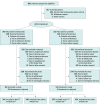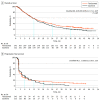Tislelizumab vs Sorafenib as First-Line Treatment for Unresectable Hepatocellular Carcinoma: A Phase 3 Randomized Clinical Trial
- PMID: 37796513
- PMCID: PMC10557031
- DOI: 10.1001/jamaoncol.2023.4003
Tislelizumab vs Sorafenib as First-Line Treatment for Unresectable Hepatocellular Carcinoma: A Phase 3 Randomized Clinical Trial
Abstract
Importance: Hepatocellular carcinoma (HCC) is a leading cause of cancer-related mortality, and additional first-line treatments are needed. The programmed cell death protein 1 inhibitor tislelizumab demonstrated efficacy and a tolerable safety profile as second-line HCC treatment.
Objective: To investigate efficacy and safety of tislelizumab vs sorafenib tosylate for first-line treatment of unresectable HCC.
Design, setting, and participants: The open-label, global, multiregional phase 3 RATIONALE-301 randomized clinical trial enrolled systemic therapy-naive adults with histologically confirmed HCC, Barcelona Clinic Liver Cancer stage B or C disease, disease progression following (or patient was not amenable to) locoregional therapy, Eastern Cooperative Oncology Group performance status of 1 or less, and Child-Pugh class A, between December 27, 2017, and October 2, 2019. Data cutoff was July 11, 2022.
Intervention: Patients were randomized 1:1 to receive tislelizumab, 200 mg intravenously every 3 weeks, or sorafenib tosylate, 400 mg orally twice daily.
Main outcomes and measures: The primary end point was overall survival (OS); secondary end points included objective response rate, progression-free survival, duration of response, and safety.
Results: A total of 674 patients were included in the analysis (570 men [84.6%]; median age, 61 years [range, 23-86 years]). As of July 11, 2022, minimum study follow-up was 33 months. The primary end point of OS noninferiority of tislelizumab vs sorafenib was met in the intention-to-treat population (n = 674); median overall survival was 15.9 (95% CI, 13.2-19.7) months vs 14.1 (95% CI, 12.6-17.4) months, respectively (hazard ratio [HR], 0.85 [95.003% CI, 0.71-1.02]), and superiority of tislelizumab vs sorafenib was not met. The objective response rate was 14.3% (n = 49) for tislelizumab vs 5.4% (n = 18) for sorafenib, and median duration of response was 36.1 (95% CI, 16.8 to not evaluable) months vs 11.0 (95% CI, 6.2-14.7) months, respectively. Median progression-free survival was 2.1 (95% CI, 2.1-3.5) months vs 3.4 (95% CI, 2.2-4.1) months with tislelizumab vs sorafenib (HR, 1.11 [95% CI, 0.92-1.33]). The incidence of treatment-emergent adverse events (AEs) was 96.2% (325 of 338 patients) for tislelizumab and 100% (n = 324) for sorafenib. Grade 3 or greater treatment-related AEs were reported in 75 patients (22.2%) receiving tislelizumab and 173 (53.4%) receiving sorafenib. There was a lower incidence of treatment-related AEs leading to drug discontinuation (21 [6.2%] vs 33 [10.2%]) and drug modification (68 [20.1%] vs 187 [57.7%]) with tislelizumab vs sorafenib.
Conclusions and relevance: In RATIONALE-301, tislelizumab demonstrated OS benefit that was noninferior vs sorafenib, with a higher objective response rate and more durable responses, while median progression-free survival was longer with sorafenib. Tislelizumab demonstrated a favorable safety profile vs sorafenib.
Trial registration: ClinicalTrials.gov Identifier: NCT03412773.
Conflict of interest statement
Figures


Comment in
-
Quantification of Treatment Effect of Tislelizumab vs Sorafenib for Hepatocellular Carcinoma.JAMA Oncol. 2024 May 1;10(5):674. doi: 10.1001/jamaoncol.2024.0116. JAMA Oncol. 2024. PMID: 38483380 No abstract available.
References
-
- Lencioni R, Marrero J, Venook A, Ye SL, Kudo M. Design and rationale for the non-interventional Global Investigation of Therapeutic Decisions in Hepatocellular Carcinoma and of Its Treatment With Sorafenib (GIDEON) study. Int J Clin Pract. 2010;64(8):1034-1041. doi:10.1111/j.1742-1241.2010.02414.x - DOI - PMC - PubMed
Publication types
MeSH terms
Substances
Associated data
LinkOut - more resources
Full Text Sources
Medical
Research Materials
Miscellaneous

